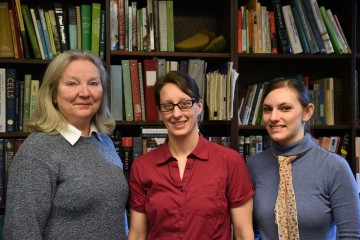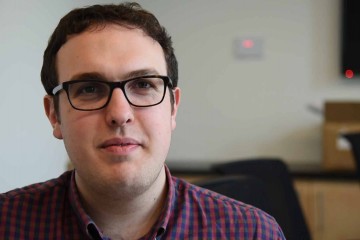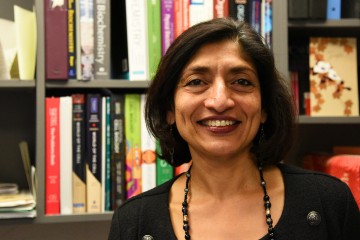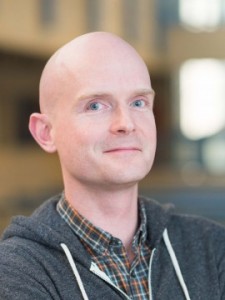The Teaching and Learning Enhancement Fund (TLEF) was created to enrich student learning by supporting innovative and effective educational enhancements. Sixty-one proposals, 16 large projects and 45 small projects, were recently funded for the 2016-17 year.
CTLT talked to applicants of three different TLEF funded proposals about how the idea for their projects emerged, the ways in which their project will enrich student learning and their overall goals.
Use the quick links below to navigate through the projects.
- Blended learning to enhance student learning experience in a large undergraduate Biology laboratory course
- Sustainability Case Studies: A Model for Interdisciplinary Learning and Showcasing of Student Work
- Stop-motion Animations as Learning Objects for Flexible Learning in Biology and Psychology Courses
- Developing a UBC-Aboriginal Timeline with Musqueam content – Time and Place at UBC: Our Histories and Relations
Title: Blended learning to enhance student learning experience in a large undergraduate Biology laboratory course
Faculty: Science
Principal applicants: Pamela Kalas, Kathy Nomme, Natalie Schimpf
Collaborators: Lynn Norman, Chin Sun, Berardita Germano, Maryam Moussavi, Brett Couch, Eric Jandciu
Students impacted: 1500
Grant value: $97,922
The Biology 140 blended learning project will capitalize on blended learning to 1) develop and incorporate appropriate scaffolding resources and opportunities to practice and connect the fundamental elements of scientific inquiry/investigation and communication and 2) raise student motivation and perceptions of the relevance of their lab activities by making explicit connections to current research at UBC.
How did the idea for this project emerge?

From left to right: Kathy Nomme, Pamela Kalas and Natalie Schimpf
Kathy Nomme: In Biology 140 we are introducing students to investigations in biological sciences. There are many skills that undergraduate students need to develop including finding appropriate information, critically reviewing information and developing means of testing their ideas. We already have some support materials in place, but the TLEF will allow us to tailor instructional interactive tutorials that will better guide students in developing these skills. Over the course of 20 or so years, [the course has] accumulated all kinds of supports and add-ons and activities that actually made the course very full. It came to a point where we were asked to review the course, to get back to its essential components and make sure that we were providing the students with sufficient scaffolding so that they could be more successful.
Pamela Kalas: What was unique about how this project emerged is that really the need for revision emerged from student and TAs feedback. It’s not often that feedback from students is taken so seriously as to go forward and revise a whole course. The other side of it is UBC flexible learning initiative and the idea of using or making the best possible use of online resources to see if we can support students better. We want the materials to be enticing. The students have to be motivated to watch the video, do the tutorial.
Natalie Schimpf: In addition to the fact they felt the workload was really high, they felt that expectations and clarification around assignments and assessment wasn’t as clear as they would like it to be, and we’ve got preliminary data to suggest that that’s improved drastically.
How will this project help enrich student learning? How will it impact teaching?
NS: I think [students] will feel more supported because although there was a lot of supporting materials before, I don’t know that it was quite as targeted and as aligned with what we were expecting them to do.
KN: On impacting the teaching, it probably will take the pressure off some of the instructors, some of our TAs because the quality of the lessons will be consistent throughout. The students are all going to get the same message — how they interpret that information will be a different story. How will it impact student learning? I think it’s going to make it more interesting for them.
PK: I feel also for the TAs and people coming in to teach the course, that these online materials can serve as references. I remember the first time I taught the course. TAs and instructors could also watch the online material ahead of time that should clarify issues around language and structure of classes as well as add to the consistency.
What are your main goals with this project?
NS: To give them an authentic experience or first exposure to science and biology research.
KN: We want the students to learn something, but we don’t want them to be overburdened. We want them to enjoy what they’re doing and inspire them to carry on, to pursue their own interest. We want to make sure the TAs and other instructors get something out of this, so that they are not overburdened, and so we only get the best TAs wanting to come and teach in the course. I think for us too, we want to see students progress and seeing the benefit of what we are trying to teach them.
PK: Another thing we are trying is to include and make references to some of the biology research that happens at UBC. We are trying to do that through video interviews with some of the researchers who do work that relates to what students are doing in the lab so that they realize that they’re not just going through the motion, but they use the same techniques for their research.
Title: Sustainability Case Studies: A Model for Interdisciplinary Learning and Showcasing of Student Work
Faculty: Arts
Principal applicant: Daniel Munro
Collaborators: Christina Hendricks
Students impacted: 500
Grant value: $14,954
The project brings together faculty and students from across departments and Faculties to co-create an interdisciplinary, open educational resource on sustainability and environmental ethics. A “sprint” will be used to start the resource, but students and faculty will continue to add to it later to ensure its evolution and expansion over time.
How did the idea for this project emerge?

Daniel Munro is the Associate VP Academic and University Affairs at the UBC AMS.
Daniel Munro: This project emerged from work that the AMS has been doing to promote the creation and adoption of Open Educational Resources (OER) at UBC, in collaboration with various faculty and staff. Open education has been one of the main priorities for the AMS VP Academic and University Affairs during the 2015-2016 school year, and we have been working to educate faculty and students about the benefits of adopting OER: cost saving for students, as well as opportunities to engage in “open pedagogy.” One of the most exciting forms of open pedagogy for us is when professors design assignments that allow students to contribute to educational resources for wider audiences, such as students in future years who learn from the work of past students. These assignments allow students to take a more active role in being part of UBC’s knowledge-sharing community, rather than simply turning in assignments that only their professor will see. We realized that one of the best ways to encourage uptake of such teaching practices was to create an OER of our own, one that allows students to participate in creating educational content. We chose to create an OER about environmental ethics, given that this topic can be approached from a variety of disciplines, and also since sustainability is a priority for the AMS and UBC.
How will this project help enrich student learning? How will it impact teaching?
DM: Firstly, giving students an open platform in which to contribute their work, to be shared with other students and faculty, is a means of increasing engagement and motivation, and this is made possible by the fact that the resource will be an editable OER on the UBC Wiki. Secondly, this resource will feature perspectives on issues in environmental ethics from a variety of different disciplines that span several departments and Faculties. Because these are complex problems that can be approached from many directions, this is meant to help faculty and students from various disciplines to see how others would approach the same topics. This allows for disciplinary silos to broken down, and for instructors to inject an interdisciplinary perspective into their teaching.
What are your main goals with this project?
DM: Our main goal is to create a resource that is used in many courses across many departments, thus impacting learning for hundreds of students in the ways described above. We hope that these students’ course engagement will be invigorated by an opportunity to contribute to a lasting resource used by future students. We also hope that more students and faculty become aware of the benefits of OER, and the importance of allowing students to take a more active role as scholars who make lasting contributions. Students will also learn about how to use platforms like the UBC Wiki, and how scholarship is evolving through digital and open ways of disseminating research.
Title: Stop-motion Animations as Learning Objects for Flexible Learning in Biology and Psychology Courses
Faculty: Science
Principal applicant: Sunita G. Chowrira
Collaborators: Steven Barnes
Students impacted: 2200
Grant value: $21,834
The project uses stop-motion animations as ‘Learning Objects’ in supporting the existing ‘Learning Path’ model of the Flexible Learning Initiative in Biology (BioFlex) project. Grant recipients will produce ten stop-motion animations that deal with biological topics that students struggle with and/or are difficult to teach using traditional instructional methods.
How did the idea for this project emerge?

Sunita Chowrira has partnered with Dr. Steven Barnes in this TLEF project.
Sunita Chowrira: The main idea related to this came from some work that I had initiated in my 2nd year Biology courses (BIOL 200 and BIOL 201) – getting students to develop “Learning Objects”. I was first introduced to the idea of “Learning Objects” during a conversation with Dr. Simon Bates – he talked about introducing it in his first year Physics course. I was intrigued and needed to learn more about it! “Learning Objects” are small, self-contained digital resources with integrated learning objectives, a learning activity, and an assessment component (*William, 2000). In collaboration with a group of students in our advisory team, we identified a set of topics that students found challenging to learn. For each of these topics we will develop learning objects. The format of the “learning activity” within the learning objects could be anything from graphics to animations to a simple video. This is where Dr. Steven Barnes comes in. Steven is an amazing stop-motion animation producer – the best! At a conference I saw one of Steven’s productions (https://www.youtube.com/watch?v=8ENRL4xySGg) and I knew I had to collaborate with Steven on my Learning Objects project for Biology. Steven will be producing all of the narrated stop-motion animations for our learning objects in this project.
*Williams, D. D. (2000). “Evaluation of learning objects and instruction using learning objects.” In D. A. Wiley (Ed.), The Instructional Use of Learning Objects: Online Version.
How will this project help enrich student learning? How will it impact teaching?

Steven Barnes is an instructor in the Department of Psychology at UBC.
SC: This project is going to let us put in place resources – the learning objects made in-house – that are directly aligned with the learning objectives, the things that we do in class, and also directly aligned with the way students are assessed. The narrated animation videos would be housed and deployed online, so students may access them whenever, wherever and however many times they may want to engage with it. Class time will be used for activities at higher cognition levels where students will have the opportunity to interact with instructors as they learn to apply the material. Outside of class time students will be able to access the material as needed for practice and mastery – this aligns nicely with our BioFlex model (Flexible Learning in Biology), which is guided by the principle tenet that the activity of learning will continue not just in the classroom, but also outside the classroom and beyond the termination of a course.
How will it impact teaching? By having this kind of resources readily available and accessible, we believe it will be less of a barrier for anyone considering to incorporate active learning approaches in their classrooms. These types of resources will also enable horizontal and vertical alignment of courses within our disciplines.
What are your main goals with this project?
SC: Our main goal is to have the right kind of resources available to make it possible to develop learner/learning-centered course designs in Biology. These resources will be used in specific Biology (BIOL 112, 200, 201) and Psychology (PSYC 304) courses initially, but we envision their use will evolve and expand over time. Another goal is also to have these learning objects serve as a spring-board for student-developed learning objects in future, which I hope to incorporate in my courses to nurture self-directed learning among my students – by encouraging and motivating students to pick a topic that they are having trouble with and develop learning objects for them. I look forward to studying the kinds of impact these might have on student learning and their learning experiences.
Title: Developing a UBC-Aboriginal Timeline with Musqueam content – Time and Place at UBC: Our Histories and Relations
Faculty: Arts
Principal applicant: Daniel Justice and Leona Sparrow
Collaborators: Hanae Tsukada and Jason Woolman
Students impacted: 1000
Grant value: $49,827
A centrepiece of an online educational resource, Time and Place at UBC: Our Histories and Relations, is a timeline, which presents major historical events of UBC and its relationship with Aboriginal peoples against the backdrop of the broader society in BC and Canada. This TLEF project creates a new timeline row that presents the history of the Musqueam Nation, including the community’s relationship with UBC.
How did the idea for this project emerge?
Hanae Tsukada: The timeline had been public since 2013, around the time of the West Coast National Event of the Truth and Reconciliation Commission. When I went to c̓əsnaʔəm, the City Before the City exhibit at the Museum of Vancouver in January 2015, it became really clear that my timeline didn’t have a direct connection to specific events from Musqueam. I started wanting to explore the possibility of having this history and relationship represented in the timeline. In June 2015, I had the opportunity to show the timeline to Jason Woolman (Senior Archivist) and Larissa Grant (Referrals, Research and Engagement) from the Treaty, Lands, and Resources Department of the Musqueam Indian Band. I was pleased to learn that they were willing to collaborate in adding Musqueam history and current events to the timeline. I created a formal proposal that was presented to the Musqueam Advisory Committee for the First Nations and Indigenous Studies program and CTLT Aboriginal Initiatives. Jason and the Musqueam-UBC liaison, Leona Sparrow, are part of the Committee, and they provided a lot of valuable insight from the Musqueam community for the development of the TLEF project proposal. Daniel Justice is also part of the Committee, and that’s how he became involved. I am also grateful to Amy Perreault, CTLT Aboriginal Initiatives Strategist, who supported the process from the beginning.
How will this project help enrich student learning? How will it impact teaching?
HT: In terms of teaching and learning, we may know, or at least have heard, that UBC stands on the traditional, ancestral, and unceded territories of the Musqueam peoples, but I think teaching what that means and how we at UBC – both as individuals and as an institution – have gotten to where we are today physically and socially can be a challenging task. So I wanted to create a resource that visually represents the long and continuous Musqueam presence on this land dating back prior to the “arrival” of UBC. By locating Musqueam history in parallel to UBC’s institutional history, and against the backdrop of the histories of BC and Canada in the timeline, I want students to think of Musqueam history, or more broadly colonialism in Canada, in present tense and in a localized way, rather than thinking of it as an abstract thing of the past or something that is irrelevant to them. We will create an educator guide that suggests ways to respectfully engage with and utilize the newly developed timeline in various teaching and learning settings.
Another thing I am hoping to do with this project, I am going to hire a student, ideally of Musqueam descent, to conduct archival research on Musqueam history under the guidance of Jason Woolman. In the Time and Place at UBC website, I share my learning experiences through developing the timeline, and I heard that my stories helped some students engage with learning about UBC’s history and relationship with Aboriginal peoples because they could relate to me. Similarly, I want the student we hire for this project to reflect on what they learn. Different voices speak to different people so I hope that the student’s story will create another entry point for more students’ learning.
What are your main goals with this project?
HT: The most important goal would be to create a mutually meaningful space for dialogue between the Musqueam community and UBC through consulting and collaborating with the community in every aspect of the development and implementation of this resource. Currently, the timeline consists of three rows: “Canada/BC,” “UBC,” and “UBC Aboriginal Engagement.” I want to have a Musqueam row at the top as a way to acknowledge its significance and to intentionally have us think about how it is related to all of the other rows. I hope that the Musqueam row serves as a space where Musqueam peoples share their history with educators, students, and others at UBC from their perspectives, rather than UBC speaking for them. I don’t really know how the end product of this project will exactly look like because I don’t know what will unfold from looking into Musqueam history, but that makes the project all the more exciting.

